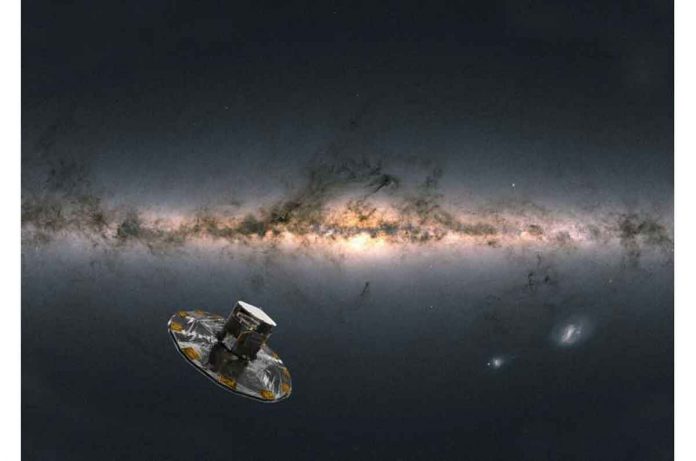Gaia is the European Space Agency’s program to produce the most precise and comprehensive multi-dimensional atlas of the Milky Way galaxy. This enables scientists to rebuild the structure and history of our home galaxy over billions of years, as well as get a deeper understanding of the lifecycle of stars and our location in the cosmos.
The third release of Gaia’s data includes new and updated details for about two billion stars in our galaxy. Chemical compositions, stellar temperatures, hues, masses, ages, and the speed at which stars travel towards or away from us are all included in the catalog (radial velocity). Much of this information came from freshly disclosed spectroscopic data, which is a technique for splitting starlight into its constituent hues (like a rainbow). Special subgroups of stars, such as those that alter brightness over time, are also included in the data.
The largest catalog of binary stars, thousands of solar system objects such as asteroids and planet moons, and millions of galaxies and quasars outside the Milky Way are also included in this data set.
One of the most striking findings from the new data is that Gaia can detect starquakes, which are minuscule disturbances on a star’s surface that modify the form of stars, something the telescope was not designed for.
Gaia has previously discovered radial oscillations, which cause stars to inflate and decrease on a regular basis while maintaining their spherical shape. However, Gaia has recently detected additional vibrations that are more akin to large-scale tsunamis. These nonradial oscillations alter a star’s global form, making them more difficult to identify.
In thousands of stars, Gaia discovered intense nonradialstarquakes. Gaia also discovered unusual vibrations in stars that had never been observed before. According to current theory, these stars should not have any quakes, however, Gaia detected them on their surface.
“Starquakes reveal a great deal about stars, particularly their inner workings. Gaia is creating a goldmine for large star ‘asteroseismology.’ “ConnyAerts, a member of the Gaia collaboration from KU Leuven in Belgium, agrees.
What stars are made of can inform us about their birthplaces and subsequent journeys, and hence about the Milky Way’s history. Gaia is presenting the galaxy’s largest chemical map related to 3D movements, from our solar neighborhood to smaller galaxies encircling ours, with today’s data release.
Some stars have a higher proportion of “heavy metals” than others. Only light components were generated during the Big Bang (hydrogen and helium). All other heavier elements, which astronomers refer to as metals, are created inside stars. When stars die, these metals are released into the interstellar medium, which is made up of gas and dust between the stars and from which new stars develop. Metal-rich environments will result from active star development and death. As a result, the chemical composition of a star is similar to that of its DNA, providing essential information about its origin.
We can observe that certain stars in our galaxy are comprised of primordial material, while others, such as our sun, are made of stuff enriched by past generations of stars, thanks to Gaia. Metals are more abundant in stars closer to the galaxy’s center and plane than in stars farther away. Based on their chemical composition, Gaia was able to identify stars that originated in galaxies other than our own.
“Our galaxy is a wonderful melting pot of stars,” says Alejandra Recio-Blanco, a member of the Gaia project from the Observatoire de la Côte d’Azur in France.
“This diversity is critical because it teaches us about the creation of our galaxy. It reveals the dynamics of migration and accretion from other galaxies within our galaxy. It also plainly demonstrates that our sun, like us, is part of an ever-changing system generated by the collision of stars and gas from various sources.”
Other recent articles demonstrate the range and depth of Gaia’s finding potential. A new binary star catalog details the mass and history of over 800,000 binary systems, while a new asteroid study of 156 thousand stony rocks reveals more about our solar system’s beginnings. Gaia is also learning about 10 million variable stars, enigmatic macro-molecules between stars, and quasars and galaxies beyond our own cosmic neighborhood.
“Gaia is a survey mission, unlike other missions that target specific objects. This means that Gaia is bound to find discoveries that other more committed missions would overlook when studying the entire sky with billions of stars numerous times. This is one of its strengths, and we can’t wait for the astronomical community to dig into our new data to learn even more about our galaxy and its environs than we ever dreamed possible “TimoPrusti, ESA’s Gaia Project Scientist, agrees.
Gaia is the European Space Agency’s program to produce the most precise and comprehensive multi-dimensional atlas of the Milky Way galaxy. This enables scientists to rebuild the structure and history of our home galaxy over billions of years, as well as get a deeper understanding of the lifecycle of stars and our location in the cosmos.

